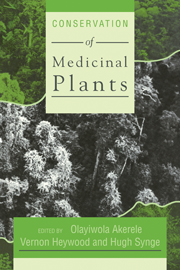Book contents
- Frontmatter
- Contents
- Contributors
- Preface
- Acknowledgements
- The Chiang Mai Declaration
- Introduction
- The Issue of Medicinal Plants
- Science, Industry and Medicinal Plants
- Techniques to Conserve Medicinal Plants
- Policies to Conserve Medicinal Plants
- Experiences from Programmes to Conserve Medicinal Plants
- 21 Medicinal Plants in India: Approaches to Exploitation and Conservation
- 22 The Chinese Approach to Medicinal Plants – Their Utilization and Conservation
- 23 Conservation of Medicinal Plants in Kenya
- 24 Complexity and Conservation of Medicinal Plants: Anthropological Cases from Peru and Indonesia
- 25 Utilization of Indigenous Medicinal Plants and their Conservation in Bangladesh
- 26 Development of a Conservation Policy on Commercially Exploited Medicinal Plants: A Case Study from Southern Africa
23 - Conservation of Medicinal Plants in Kenya
Published online by Cambridge University Press: 07 September 2010
- Frontmatter
- Contents
- Contributors
- Preface
- Acknowledgements
- The Chiang Mai Declaration
- Introduction
- The Issue of Medicinal Plants
- Science, Industry and Medicinal Plants
- Techniques to Conserve Medicinal Plants
- Policies to Conserve Medicinal Plants
- Experiences from Programmes to Conserve Medicinal Plants
- 21 Medicinal Plants in India: Approaches to Exploitation and Conservation
- 22 The Chinese Approach to Medicinal Plants – Their Utilization and Conservation
- 23 Conservation of Medicinal Plants in Kenya
- 24 Complexity and Conservation of Medicinal Plants: Anthropological Cases from Peru and Indonesia
- 25 Utilization of Indigenous Medicinal Plants and their Conservation in Bangladesh
- 26 Development of a Conservation Policy on Commercially Exploited Medicinal Plants: A Case Study from Southern Africa
Summary
Introduction
Kenya is located on the equator in East Africa, and has a total land area of 582,644 sq. km. The land rises gradually from the sea in the south-east to about 1,800 m some 500 km inland where the Great Rift Valley divides it from north to south. The valley is about 70 km wide and 300 m deep with precipitous walls in some parts. The land slopes gradually down to the Lake Victoria shore at 1070 m on the west of the Rift Valley. There are two main mountain masses of Mt Kenya (5199 m) and Aberdare Mts (3964 m) to the east of the Rift Valley, and the Mau Range (3097 m) and Mt Elgon (4321 m) to the west.
More than half of Kenya in the north and north-eastern parts and also in the southern section of the Rift Valley floor is composed of arid or semi-arid land. Most western part of the country, and the higher land from 1370m to 2740m in the central part receives a good rainfall and are fertile. The mountain slopes and these areas of high rainfall had in the past been characterised with dense natural high forests.
The need to conserve the individual medicinal plants used is brought about by the rapid increase of population and more demand for land for both agriculture and human settlement. The estimated population in 1960 was 6.5 million people, and the present (1987) estimate is three times that figure. A number of the medicinal plants widely exploited are from the natural forests.
- Type
- Chapter
- Information
- Conservation of Medicinal Plants , pp. 315 - 320Publisher: Cambridge University PressPrint publication year: 1991
- 4
- Cited by



